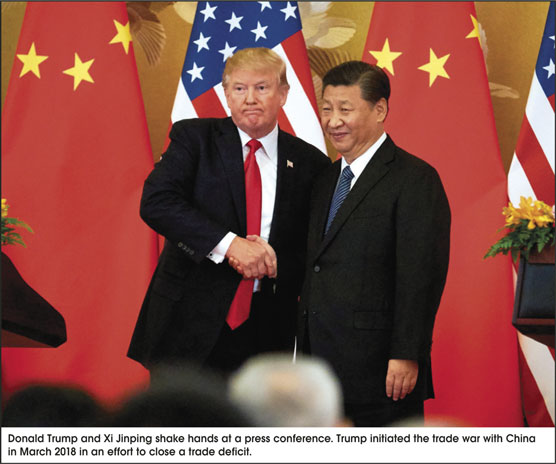by MAURA KELLER
In early December 2019, President Trump announced he would impose tariffs on steel and aluminum from Brazil and Argentina, a move that alters previous agreements with those countries.

Likewise, in mid-October 2019 President Trump said he would increase the Section 232 tariffs on Turkish steel from 25 to 50 percent, as a result of the country’s military actions in Northeast Syria. Additionally, during the height of 2019’s holiday season, the president stated that as part of the U.S.-China trade deal, the U.S. will not charge Beijing with any new tariffs and will slightly reduce existing ones. These announcements and the ongoing changes facing the tariff environment could potentially expand the global trade war that has been on the minds of recyclers for the last couple of years. In fact, this “seesaw” effect of today’s tariff environment is causing many industries, including recycling companies, to keep a constant watch on the evolving tariff situation.
It’s been almost two years since Trump initiated his trade war with China in March 2018 in an effort to close a trade deficit. In the ensuing months, the president imposed tariffs on more than two-thirds of all Chinese goods. This strategy had ripple effects throughout the metals recycling market for months afterward.
According to Peter Quinter, shareholder and customs attorney at GrayRobinson, based upon a report prepared by the U.S. Department of Commerce in March 2018, president Trump issued proclamations stating that the importation of steel and aluminum was a national security threat to critical industries in the U.S.
“Pursuant to the authority of Section 232 of the Trade Expansion Act of 1962, he imposed an extra tariff of 25 percent on virtually all imported steel and an extra tariff of 10 percent on virtually all imported aluminum effective March 23, 2018. On May 19, 2019, the steel and aluminum tariffs were removed for both Mexico and Canada as part of the U.S.-Mexico Canada Agreement (USMCA) negotiations to replace the NAFTA,” Quinter said.
Mike Jenny has more than 15 years of experience in the metals industry at Livingstone Partners, and has a keen understanding on production, distribution, fabrication and recycling across a variety of metals and specialty materials.
As Jenny explained, the initial tariff effects were temporary; domestic steel producers experienced an initial jolt in earnings, however, the market has settled into a new lower pricing dynamic driven in part by supply and demand imbalances domestically.
“In the year since the tariffs took effect, benchmark steel prices have fallen well below their level before the tariffs took effect,” Jenny said. “Moreover, at the steel producer level, downstream producers saw increased output costs as consumers of steel. Imported steel was expensive and priced out of reach and domestic prices increased to match import pricing, putting the steel out of reach on both sides.” Tariffs have also driven industry consolidation, such as Cleveland Cliffs’ acquisition of AK Steel as well as several metal recycling related deals Livingstone Partners actively participated in.
“A final tariff agreement has not been reached by the Trump administration,” Jenny said. “Tariffs are still in place and they tend to fluctuate up and down for certain countries. Tariffs are largely holding constant, save in the case of Turkey where they were up and are now back down.”
So what impact does the current tariff situation and its subsequent fluidity have on the metals market? As Quinter explained, if United States Steel Corporation’s stock value is any indication, after Trump’s steel tariffs were implemented, the value of the stock doubled to a high of $46. Since then, it has been on a constant downward trend, and is now only about $11, which is about half the value when the extra steel tariffs went into effect.
“As with other industries broadly affected by President Trump’s tariffs, prices of steel and aluminum were higher in 2018 when the extra tariffs were initially implemented but have been down-trending ever since,” Quinter said.
Soon after President Trump imposed extra tariffs on Chinese products, China responded with tariffs of its own, including a 25 percent tariff on scrap aluminum.
According to Quinter, U.S. recycling operations found themselves on the front lines of the trade war as China shifted its purchase of scrap metals to other countries.
“Consequently, scrap metal prices have dropped in the U.S. The U.S. has an oversupply of domestically produced steel, aluminum and stainless scrap,” Quinter said.
As Jenny further explained, on the recycling front, the tariffs have caused a price drop for a number of reasons:
•There were no tariffs or price protection on scrap metal for imports.
•There was decreased demand for exported scrap.
•Supply outpaced demand. Due to relatively high manufacturing rates, scrap has continued to be generated despite diminished export demand and lower utilization rates by domestic steelmakers.
“Ultimately, it changed how people operated in 2019,” Jenny said.
As a result of the December 2019 “Phase One” deal with China, President Trump agreed to a limited trade agreement with Beijing that will roll back existing tariff rates on Chinese goods and cancel new levies. Specifically the deal reduces some U.S. tariffs in exchange for more Chinese purchases of American products, and better protection for U.S. intellectual property. Under the deal, the U.S. will continue to levy a 25 percent tariff on about $250 billion of imported Chinese goods, but tariffs on another $120 billion of imports would be reduced to 7.5 percent. In addition, China agreed to increase purchases of American products and services by at least $200 billion over the next two years – nearly doubling U.S. exports to China.
The constant ebb and flow of the tariff situation means the scrap recycling industry is facing its own share of ups and downs. In Quinter’s opinion, the scrap recycling business is unlikely to recover until the extra tariffs on imported steel and imported aluminum are removed.
“It’s a common misperception that foreign exporters to the U.S. directly pay the tariffs, however, it is always the U.S. import company which pays these extra taxes, and then passes them on eventually to the consumer, resulting in higher costs,” Quinter said. “If President Trump cancelled his extra tariffs on imported steel and aluminum, and products made from those metals, the rest of the world would cancel their retaliatory tariffs, China would probably resume its purchases of recycled metals from the U.S., and international trade would return to ‘normal.’”
Jenny added that if anything, it’s important to note the cyclical nature of the recycling industry and the fact that the tariffs aren’t permanent. That said, tariffs are the new normal within the industry and have fostered uncertainty in the market.
“Recycling companies would do well to focus on efficiency,” Jenny said. “The companies successfully weathering this challenging period work hard to never buy more than they need and sell within as short time-frame as possible – which admittedly is easier said than done.”
Published in the February 2020 Edition







